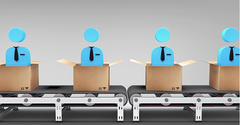Marketing Automation Strategy: The Definitive Guide

We all receive the annoying "automated email or text message" causing us to roll our eyes. More noticeably, we have seen these communications originate from even Fortune 500 companies who we expect have the budgets to communicate properly.
What are they trying to do? What drives these types of communication? Marketing automation. Automating a communication strategy properly requires careful planning. The impact of a poorly planned automation strategy: delete, unsubscribe, mark as SPAM. A company in today's marketplace has a plethora of marketing automation tools from which to choose. Some CRM systems even incorporate automation functionality as a fundamental part of their offering.
With all these wonderful automation tools, where's the gap in execution? Proper execution on automation never begins with the tool, but how to automate. Marketing automation strategy begins with process.
And what drives process? Intent. The intent on why a company implements marketing automation.
Why do companies implement marketing automation? Most commonly, one of two beliefs drive this choice:
- To automate the customer relationship
- To facilitate timely, relevant and data-based communication
Unfortunately, not all beliefs create equal results. Let’s take a look:
Automating the Customer Relationship
This belief drives action towards automating customer relationship building. How authentic does that sound to you? And the result of this belief when implementing automation? Communications provide that same inauthentic feeling as uttering the words "automated customer relationship".
Can a real relationship be built without authenticity? Can authenticity be automated?
Consider this definition of authentic:
“Of undisputed origin, truly what something is said to be and free from pretense or deceit.”
Side Note: To arrive at the above answer required researching FOUR definitions: authenticity, authentic, genuine AND sincere! No wonder companies find this difficult to implement!
Maybe we take a look at door number two:
Facilitating Timely, Relevant and Data-Based Communication
If you received information when you wanted, about what you wanted and communicated objectively, how satisfied would you feel? Why would your customer or clients response be any different? Would considering your audience when communicating information supported by unbiased data be interpreted as “free from pretense or deceit”?
How would that impact the customer relationship?
The “Aha Moment” of Marketing Automation:
As business moves online, it becomes far more removed from customer relationships. Historically, companies built trust authentically by bridging the knowledge gap for their customers. As people take the initiative to learn more themselves, this method of building trust becomes more and more obsolete resulting in less customer interaction. How then do you personalize the customer experience where the interaction becomes increasingly governed by technology rather than people?
Answer: "It starts with the intent to put people first under the pretext of the current environment. The intent never changed, only the delivery method to execute that intent. Herein lies the power of marketing automation strategy: automating the intent to deliver timely, relevant and data-based communications."
How to Plan an Effective Marketing Automation Strategy
Guided with the right beliefs and intent, you can properly execute your marketing automation strategically for your industry.
Remember that any effective strategy needs a good foundation: prepare your plan with the right research. I created a list of areas below providing the crucial questions to answer for the basis of that research:
-
The Buyer Persona:
- Who is your target audience?
- What about your solution impacts what they care about?
- Where do you find them?
- How do they consume information?
- How do they value information?
-
The Buyer’s Journey:
- What sequence of thoughts, decisions and/or realizations does your buyer persona go through?
- Which steps (if any) exist within the buyer’s journey where data alone provides insufficient comprehension?
- What variation of communication methods and styles can be used to facilitate an informed decision at each step?
-
The Buyer’s Behavior:
- What behaviors signify a shift in the buyer’s journey?
- What behaviors (if any) exist which signify that automated engagement provides insufficient comprehension in a particular step within the buyer’s journey?
- What behaviors suggest a communication preference?
-
The Marketing Automation for Buyer's:
- What information does the buyer require to make an informed decision which progresses them through each step of the journey?
- How do we apply understanding of behavior shift to optimize communication?
- What is the balance between top of mind awareness, buyer’s journey progression and communication saturation?
Answering these questions provides visibility on process, the type of communication which facilitates that process and the defined functionality necessary to execute that process.
Remember, marketing automation is maintained by people, executed without people, but ultimately exists for people.

Comments
144 Comments